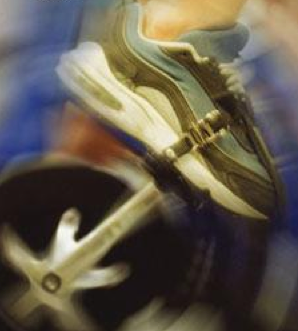 With the increase of those interested in getting a healthy start to 2012, more and more people are joining health clubs and attending indoor cycling classes. This is great! It provides a perfect opportunity to foster good technique and skills as these new members acclimate to our classes. One topic I have found myself addressing more than usual lately is proper footwear.
With the increase of those interested in getting a healthy start to 2012, more and more people are joining health clubs and attending indoor cycling classes. This is great! It provides a perfect opportunity to foster good technique and skills as these new members acclimate to our classes. One topic I have found myself addressing more than usual lately is proper footwear.
Multi-Purpose?
It is definitely a delicate balance at times as we try to encourage new or beginner riders to regularly return to class while guiding them toward good clothing and equipment choices. The more prominent issue lately is people riding with running shoes. I totally understand their mindset and appreciate their determination. They are starting this new exercise routine, which may incorporate running, weight training and cycling. Without understanding the nature of cycling, it would seem logical to just purchase a pair of running shoes and kill 3 birds with one stone (a terrible expression). As we know, this approach is not ideal when cycling is concerned.
Protect the Feet
As many of us know, the forces applied to the feet during an indoor cycling class can be great. These forces can be created by both resistance and speed alike. Simply put, if someone is wearing a running shoe, which is probably one of the worst options (besides those barefoot running shoes and Vibrams), the sole will flex placing stress on the feet. Under heavy resistance, a shoe with a soft sole will bend over the pedal, straining the intrinsic muscles of the foot plus ligaments, tendons and joints. In a similar fashion, high speeds can encourage riders to dorsiflex (angle their foot and toes upward) in order to stabilize the pedal. This exaggerated (and unnecessary) dorsiflexion can stress the extensors on the top of the foot and lower leg. To protect the feet from injury (and fatigue) from these strenuous forces, cycling shoes were created with stiff soles.
You Don”™t Even Need Cleats
It can be very intimidating to learn all there is to know about the different types of cycling shoes, cleats, pedals, etc. Even though to us it appears very simple, to a person new to exercising in general, this can be overwhelming. We toss out terms like “SPD pedals” and “clipless”. Just think how confusing that can be…you “clip” into your “clipless” pedals. I try to put new riders at ease and tell them the most important reason to purchase a cycling shoe is to protect the feet. So I will often encourage the seemingly overwhelmed person to just by the shoes WITHOUT the cleats. I”™ll of course educate them on the benefits of having a cycling shoe designed for walking when off the bike and write down “SPD” for them as they venture to the wilds of the local bike shop (where a techy geek with too much knowledge and not enough education may lurk in the darkness). Once they wrap their minds around the shoes and experience the vast difference, we take the next step toward cleats.
Bring on the Power and Performance
The rigidity of the soles on cycling shoes provides a more stable platform for delivering force to the pedals. Remember the foot is a “lever” and both the ankle and attachment to the crank arm (pedal axle) are the fulcrums. If the sole of the shoe is not firm, the power being delivered to the pedals will be affected.
In addition, without proper support or a firm platform, the muscles of the feet can fatigue. This muscle fatigue can lead to burning, pain and/or injury.
SPECIAL NOTE: If your cycling shoes are more than 3 years old, consider getting a new pair. Over time (considering the amount of use), the upper part of the shoe can stretch and the sole of the shoe can develop small, often unseen, cracks in the plastic, or breaks in the fibers (carbon soles). As the shoe loses its rigidity, its ability to support the foot and transfer power to the pedals diminishes.
------------------------------------------------
Whether it is spurring on the newcomer or persuading the veteran rider, help them understand the safety and performance benefits of using proper cycling shoes. If all else fails, convince them to at least switch to a tennis or basketball sneaker, which provide far more support than running shoes.
Originally posted 2012-01-26 17:14:35.
- Make Recovery Work - July 23, 2024
- The Effects of Cadence (Part 3) Power Output or Strength Development - July 17, 2024
- Don't Touch My Drivetrain! - June 14, 2024

I’m with you here on footwear, Tom.
I can’t decide what to recommend to members as a “first buy”…..either bike shorts for “crotch hygiene” or bike shoes for comfort.
I didn’t realise how much difference it made until I attended a fitness conference that wasn’t equipped for SPD’s. after I’d become accustomed to them. I had to wear my sneakers all day and ended up thinking…..is this how I used to feel?
Back in the day when I had to get experience subbing whereever I could, I would take my regular bike shoes….plus another pair without the cleats (or is it the clips?) Just the rigid sole made the difference between spreading the point load and comfort vs. sneakers and agony.
Vivienne
Thank you, Tom! I’m teaching an intro to cycling session soon, and footwear is one of the topics. Now I have some great points already outlined from this article! 🙂